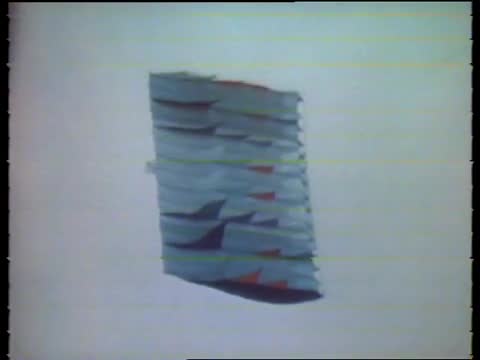The World We Live in; The Weather Watchers
- Series
- The World We Live in
- Episode Number
- 28
- Episode Number
- 2
- Episode
- The Weather Watchers
- Producing Organization
- National Educational Television and Radio Center
- Contributing Organization
- Library of Congress (Washington, District of Columbia)
- AAPB ID
- cpb-aacip/516-hq3rv0dz91
- NOLA Code
- WWLI
If you have more information about this item than what is given here, or if you have concerns about this record, we want to know! Contact us, indicating the AAPB ID (cpb-aacip/516-hq3rv0dz91).
- Description
- Episode Description
- The episode begins with a statement that hurricanes remind us that we do not know enough about them to control them. However in some areas where a hurricane would once have caused thousands of deaths, the figure is now less than a dozen, thanks to weather satellites which warn residents.?Operation Ghost in Christchurch, New Zealand, is presented. The name 'ghost" comes from the transparent Milar balloons which carry sun-powered electronic equipment to watch the weather. Some 100 long-range balloons are employed in this operation, but many thousands more of these devices are needed throughout the world to keep a close watch on the weather.?Another segment shows kites being sent into the clouds with electronic equipment to find out how ice crystals and clouds are formed. Time-lapse cameras also are used to record cloud formations so that data can be studied with a motion-picture projector. Dish pan-like devices filled with water and instruments are rotated like the earth to study weather habits.?Today computers draw weather maps much faster than man. Computers are valuable in forecasting the weather and less dangerous than exposing human beings to hurricanes. Nevertheless, we must still depend upon human beings to a great extent as world-wide weather watchers because we are a long way from automatically recording the weather.?Scientists are also trying to find out what part electricity plays in forming the raindrop. Rainmaking has been attempted for many years; in early attempts to make it rain, dynamite-loaded kites were exploded in the clouds. Scientists have now succeeded in causing rain by using airplanes to "seed" clouds with ice particles. The modern rainmaking business also employs burners to send chemical into the atmosphere. (Description adapted from documents in the NET Microfiche)
- Episode Description
- This episode is devoted to scientists around the world who watch the weather on the ground and in the upper stratosphere to seek possible means of eventually controlling it. Although closer attention is being devoted to the weather than ever before ? color-television satellites and weather stations in remote islands of the Pacific ? there is still inadequate information to determine exactly what is happening in the world's atmosphere. Weather monitors cover only about 10 per cent of the earth's surface. However great progress is being made. Planes are used for measuring hurricane force which can equal a million tons of TNT every few minutes. Computers perform about one billion mathematical operations in less than 20 minutes, but the number will have to be multiplied by one-thousand times for true global forecasting.?The film shows one of the more successful experiments in weather watching ? Project Ghost. This operation employs long-range balloons which float at altitudes between 15 and 50 thousand feet and carry sun-powered electronic instruments. One of these balloons has made 32 trips around the earth in less than a year.?The World We Live In ? "The Weather Watchers" is a National Educational Television presentation, co-produced by NET and Time-Life Broadcast, Inc., derived from "The Weather," in the Nature Library published by Time-Life books. Assistance for this production was rendered by National Center for Atomic Research, New Mexico Institute of Mining and Technology, U. S. Navy, National Meteorological center, Bell Telephone Laboratories, and British Broadcasting Corporation. This episode was first aired as Episode 2 in 1968 and was reaired as Episode 28 in 1971. Episode Running Time: 29:03 (Description adapted from documents in the NET Microfiche)
- Series Description
- The episodes in this series are derived from selections in the Nature and Science Libraries, published by Time-Life Books. Combining the latest in film and animation techniques, the series covers the general background of each of the subject areas. The World We Live in consists of 38 half-hour episodes (although episodes 27 - 38 are repeats of episodes 1 - 12), which were originally recorded in color on videotape. (Description adapted from documents in the NET Microfiche)
- Broadcast Date
- 1968-11-17
- Broadcast Date
- 1971-03-21
- Asset type
- Episode
- Genres
- Documentary
- Media type
- Moving Image
- Credits
-
-
Executive Producer: Prowitt, David
Executive Producer: Wolff, Lothar
Producer: Prowitt, David
Producing Organization: National Educational Television and Radio Center
- AAPB Contributor Holdings
-
Library of Congress
Identifier: 2335860-1 (MAVIS Item ID)
Format: 2 inch videotape
Generation: Master
-
Library of Congress
Identifier: 2335860-2 (MAVIS Item ID)
Format: 16mm film
Generation: Copy: Access
Color: Color
If you have a copy of this asset and would like us to add it to our catalog, please contact us.
- Citations
- Chicago: “The World We Live in; The Weather Watchers,” 1968-11-17, Library of Congress, American Archive of Public Broadcasting (GBH and the Library of Congress), Boston, MA and Washington, DC, accessed July 16, 2025, http://americanarchive.org/catalog/cpb-aacip-516-hq3rv0dz91.
- MLA: “The World We Live in; The Weather Watchers.” 1968-11-17. Library of Congress, American Archive of Public Broadcasting (GBH and the Library of Congress), Boston, MA and Washington, DC. Web. July 16, 2025. <http://americanarchive.org/catalog/cpb-aacip-516-hq3rv0dz91>.
- APA: The World We Live in; The Weather Watchers. Boston, MA: Library of Congress, American Archive of Public Broadcasting (GBH and the Library of Congress), Boston, MA and Washington, DC. Retrieved from http://americanarchive.org/catalog/cpb-aacip-516-hq3rv0dz91
